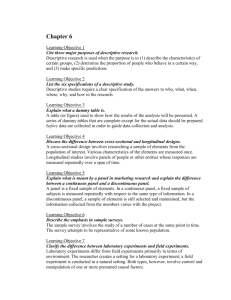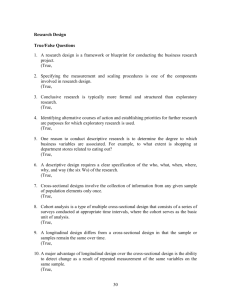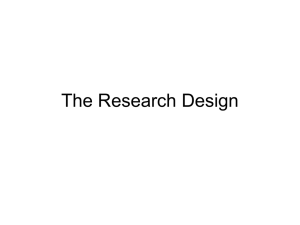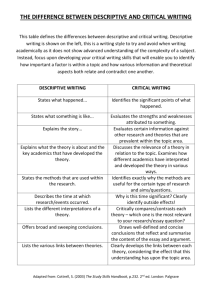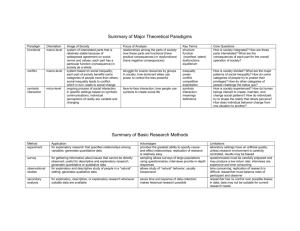Chapter 5 Research design
advertisement
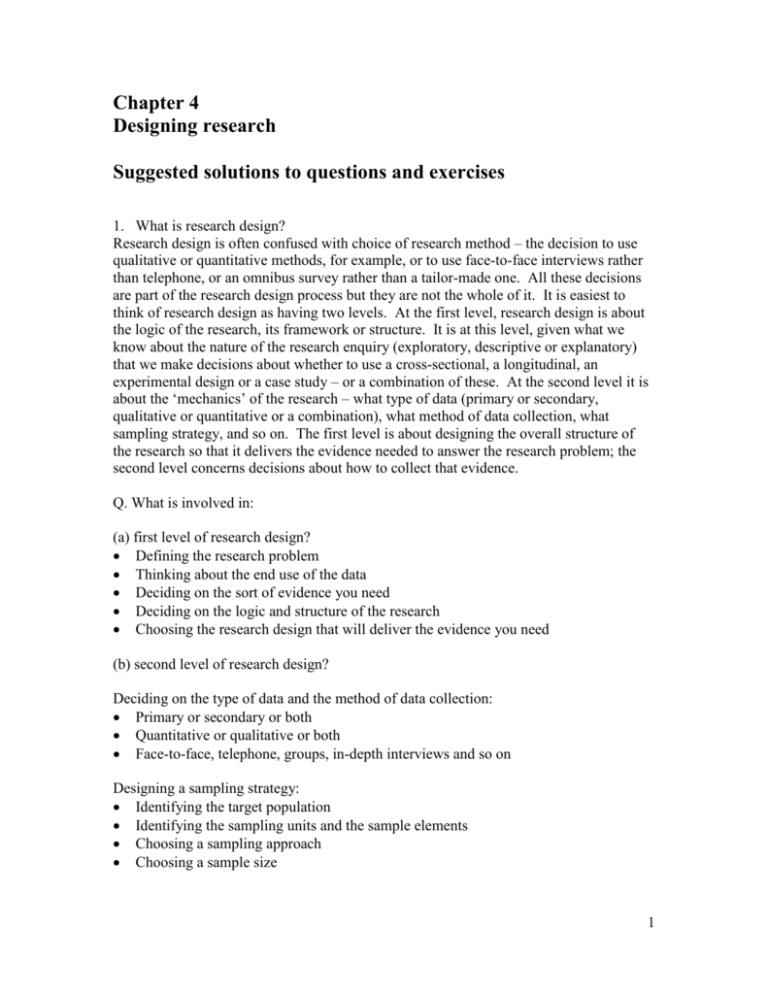
Chapter 4 Designing research Suggested solutions to questions and exercises 1. What is research design? Research design is often confused with choice of research method – the decision to use qualitative or quantitative methods, for example, or to use face-to-face interviews rather than telephone, or an omnibus survey rather than a tailor-made one. All these decisions are part of the research design process but they are not the whole of it. It is easiest to think of research design as having two levels. At the first level, research design is about the logic of the research, its framework or structure. It is at this level, given what we know about the nature of the research enquiry (exploratory, descriptive or explanatory) that we make decisions about whether to use a cross-sectional, a longitudinal, an experimental design or a case study – or a combination of these. At the second level it is about the ‘mechanics’ of the research – what type of data (primary or secondary, qualitative or quantitative or a combination), what method of data collection, what sampling strategy, and so on. The first level is about designing the overall structure of the research so that it delivers the evidence needed to answer the research problem; the second level concerns decisions about how to collect that evidence. Q. What is involved in: (a) first level of research design? Defining the research problem Thinking about the end use of the data Deciding on the sort of evidence you need Deciding on the logic and structure of the research Choosing the research design that will deliver the evidence you need (b) second level of research design? Deciding on the type of data and the method of data collection: Primary or secondary or both Quantitative or qualitative or both Face-to-face, telephone, groups, in-depth interviews and so on Designing a sampling strategy: Identifying the target population Identifying the sampling units and the sample elements Choosing a sampling approach Choosing a sample size 1 Designing the data collection instrument: Defining the concepts, choosing indicators, operationalising the concepts Designing the questionnaire or discussion guide 2. Why is research design important? Research design is important because we rely on it to deliver the evidence necessary to answer the research problem as accurately, clearly and unequivocally as possible. A sound research design is the framework on which good quality research is built. 3. What do the following terms mean: internal validity and external validity? Validity is a key concept in assessing the quality of research. It refers to how well a research design (and the research method and the measures or questions used) measures what it claims to measure – in other words, how well it gives us clear and unequivocal evidence with which to answer the research problem. Internal validity in the context of research design refers to the ability of the research to deliver credible evidence to address the research problem. Put another way, the job of the research design is to ensure that the research has internal validity. In causal or explanatory research, for example, it is about the ability of the research design to allow us to make links or associations between variables, to rule out alternative explanations or rival hypotheses and to make inferences about causality. Internal validity is important when designing questions and questionnaires. In this context, internal validity refers to the ability of the questions to measure what it is we think they are measuring. When a piece of research has external validity it means that we can generalise from the research conducted among the sample (or in the specific setting) to the wider population (or setting). 4. Describe what is meant by exploratory and descriptive research. Give examples of each type of enquiry. Exploratory research enquiry, as its name suggests, aims to explore. It is used, for example, to identify a problem, clarify the nature of it and define the scope of it, to look for insights, develop propositions and hypotheses for further research, to reach a greater understanding of an issue. It contributes to the development of a research design and should be thought of as a first stage in the research design process. Descriptive research is about finding the answers to the Who? What? Where? When? How? and How many? questions. In descriptive research, in comparison to exploratory research, you have a clearer idea of what is needed and are looking for answers to more clearly defined questions. Descriptive studies might tell you, for example, the size of a market, the structure of the market, developments over time, attitudes of particular groups of people and so on. 5. What is the aim of causal research? The aim of causal research is to provide explanations. It is also known as explanatory research for that reason. For example, it might be used to find out why people buy brand 2 A and not brand B or why some people are in favour of capital punishment and others are not. It can be used to rule out rival explanations and come to a conclusion. 6. To make sound causal inferences what sort of evidence must a research design provide? In order to make sound inferences about cause, we must make sure that the research design allows us to: look for the presence of association, covariance or correlation look for an appropriate time sequence rule out other variables as the cause come to plausible or common sense conclusions. 7. Describe: (a) what is involved in a cross-sectional research design; give examples. Cross-sectional research design allows you to collect data from a cross-section of a population at one point in time. A single cross-sectional design involves only one wave or round of data collection – data are collected from a sample on one occasion only. A repeated cross-sectional design involves conducting more than one wave of (more or less) the same research with an independent or fresh sample each time. The use of an independent sample at each round of data collection is what distinguishes repeated crosssectional design from longitudinal research. In longitudinal research, data are collected from the same sample on more than one occasion. A cross-sectional design can be used to provide data for an exploratory or descriptive research enquiry – to understand the health information needs of older people, for example. It can also be used to look for and examine relationships between variables; to test out ideas and hypotheses; to help decide which explanation or theory best fits with the data; and to help establish causal direction but not to prove cause. For example, it might be used to determine what factors are involved in the decision to take out critical illness benefit insurance, and the relationship between the factors. (b) what is involved in a longitudinal research design; give examples. Longitudinal research involves collecting data from the same sample (of individuals or organisations, for example) on more than one occasion. The number and frequency of the snapshots or data collection points depends largely on the research objectives. For example, if the purpose of the research is to look at the immediate, short-term impact of an advertising campaign, a relatively small number of data collection points, fairly closely spaced in time, may suffice; to examine the longer term impact of advertising on a brand may require a relatively large number of data collection points over many years. The main application of longitudinal design is to monitor changes in the marketing or social environment, changes that occur in the normal course of things and events that are planned, for example, changes as a result of an advertising campaign, a new product launch or an election. Longitudinal design can be used to provide data for descriptive research enquiry. Although it cannot be used to prove cause, it can be used to: 3 explore and examine relationships between variables establish the time order of events or changes, and age or historical effects help decide which explanation or theory best fits with the data help establish causal direction (rather than prove cause). (c) what distinguishes a repeated cross-sectional design from a longitudinal design. What distinguishes longitudinal designs from repeated cross-sectional designs is that in longitudinal designs data are collected from the same sample on more than one occasion, rather than from independent or fresh samples each time. 8. Describe the main stages in an experimental research design. Give an example of the application of an experimental design. Two identical samples or groups are recruited: one is known as the test group, the other is the control group. The test and control groups are matched on key criteria – in other words, the two are the same on all key characteristics. The independent variable – the one that is thought to cause or explain the change – is manipulated to see the effect that this change has on the dependent variable. This is referred to as the treatment. The treatment is applied to the test group but not to the control group. The purpose of the test group is to observe the effect of the treatment; the purpose of the control group is to act as a comparison. Since the treatment is not applied to the control group, any changes that take place will not be due to the independent variable but to some other factor(s). The design of the experiment should be such that the effect of other factors is limited or controlled. Comparison of the test and control group allows us to determine the extent of the change that is due to the independent variable only. This type of experimental design is called the ‘after with a control group’. There are variations to this design: when the independent variable and the dependent variable are measured in both groups before the ‘treatment’ takes place the design is called a ‘before and after’; if a control group is used it is called, not surprisingly, a ‘before and after with a control’. The main application of experimental research designs is to determine whether a causal relationship exists and the nature of the relationship, and to rule out the effects of other variables and to establish the time order or sequence of events (which is the cause and which is the effect). It is used in marketing experiments, for example, to make decisions about elements of the marketing mix, to evaluate effectiveness of advertisement A or B, or the weight of advertising spend, or the combination of media to be used in a campaign. An experimental design was used to examine the effects of monetary incentives on response rates to a mail survey. More specifically, to examine the relative effectiveness of pre-paid cash incentives, a prize draw for cash and a prize draw for an equivalent value non-cash prize, as methods of increasing mail survey response rates (Brennan, Hoek and Astridge, 1991). 9. What is case study research? What methods of data collection are suited to a case study approach? A case study is an in-depth investigation of a ‘case’ for exploratory, descriptive or explanatory research purposes, or a combination. A ‘case’ might be, for example, a 4 household, an organisation, a situation, an event, or an individual's experience. Case study research may involve examining all aspects of a case – the case as a whole and its constituent parts. For example, a case study of a particular household may involve data collection from individual members; in an organisation the elements of the case might be departments and individuals within departments. A case study design might be made up of several case studies, not just one. A variety of methods of data collection can be used in a case study, including analysis of documents, observation and qualitative and quantitative interviewing. 10. What type(s) of research design are suitable for a descriptive research enquiry? With the exception of experimental designs, which are limited in the descriptive data they can deliver, all research designs can produce descriptive data. The choice of a particular design, or combination of designs, depends on the precise requirements of the descriptive research enquiry. Descriptive research (and the design you choose for it) is not limited to a particular research method or technique. It can involve analysis of secondary data or the collection of primary data, or a combination of both. Quantitative or qualitative methods or both can be used. Any method of data collection, from observation to interviewing, is suitable. 5
